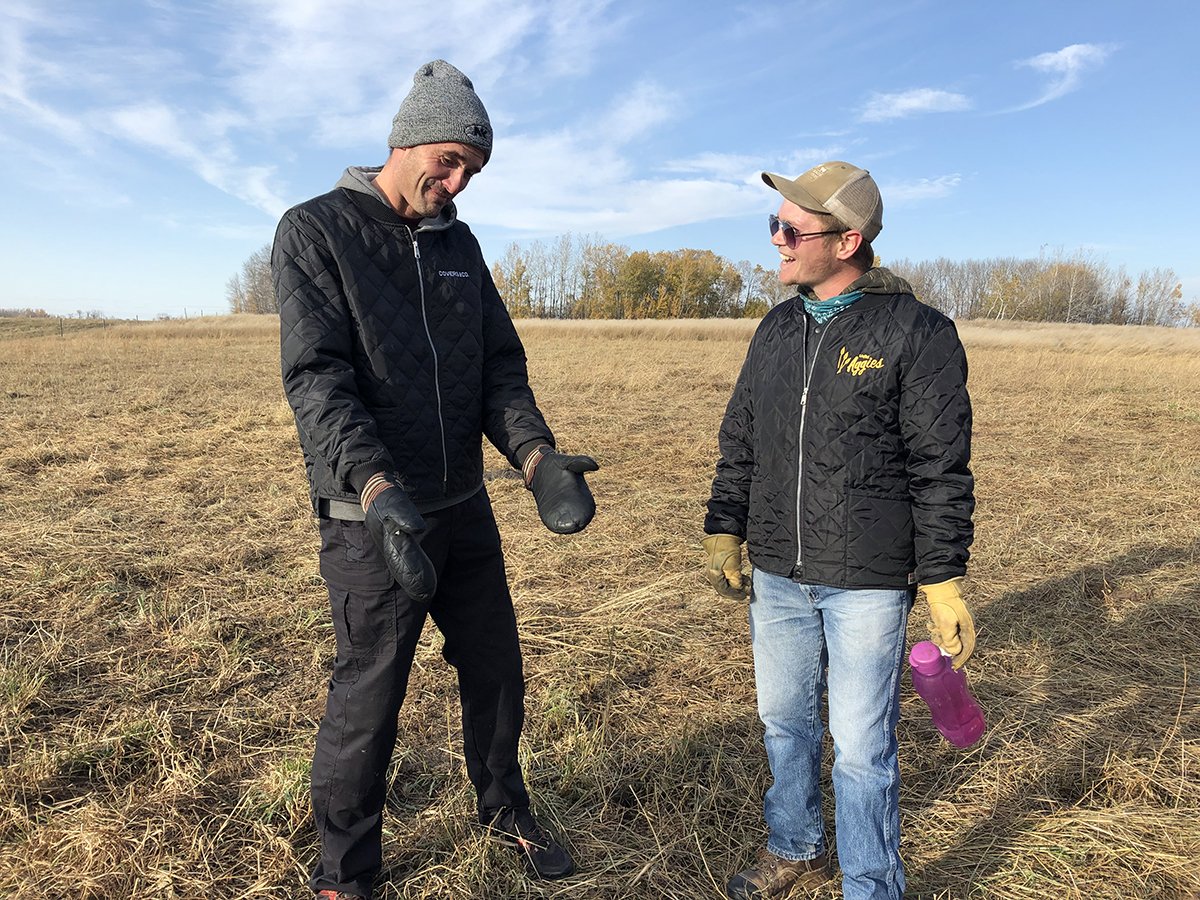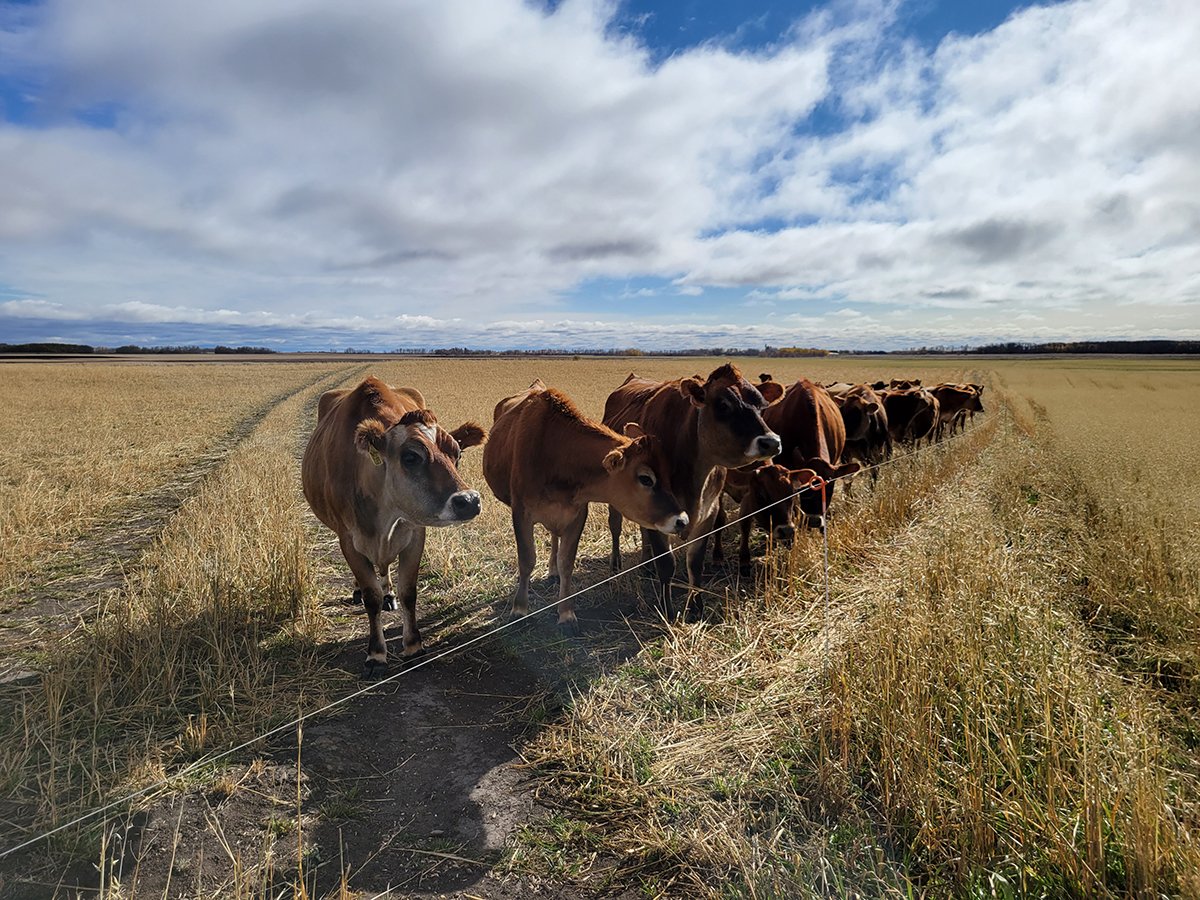One strand of electric temporary fencing stretches across a pasture on Anna Donahue’s family dairy farm in Basswood, Manitoba. The cattle have been trained to know where the lines are, and the moment Donahue starts rolling up the fence every cow barrels across the field, racing for the new food. In the new pasture the cows eagerly graze on a polycrop mix of 15 different plant species, including legumes and grasses.
Above: Cattle graze on a polycrop at Malarky Ltd.
The cows seem enthusiastic about grazing outdoors, something they couldn’t do until recently here at Malarky Farm. It’s been less than a year since the Donahue’s started rotational grazing their cattle and they are already noticing improvements.
“Not only are we happy with the results we have seen, but the cows seem happier and healthier,” Donahue says. “Rotational grazing our cows has helped reduce our input bills, and we have noticed better overall hoof health with our herd.”
Rotational grazing is a way of feeding cattle that uses multi paddocks so the cows can easily be moved from pasture to pasture. This practice can have many benefits to the producer such as reduced costs and improved soil health. Most importantly, it ensures the animals have continued access to new sources of food every day.
“Without using this practice of moving them frequently we would not be able to graze our milk cows,” says Donahue. “They wouldn't be consuming enough to keep up their milk production.”
Previously the Donahue’s grew crops in their fields and transported the feed to their impressive cattle barn. The Donahue’s have been able to get their herd back on the land with funding support for rotational grazing from the Prairie Watersheds Climate Program (PWCP).
Above: Portable temporary fencing in a cattle pasture
Rotational grazing is one of three beneficial management practices (BMPs) funded through PWCP from Agriculture and Agri-Food Canada’s Agricultural Climate Solutions – On-Farm Climate Action Fund. Cover cropping and nitrogen management are also funded through PWCP, and all three BMPs provide benefits both to the producer and to the environment.
PWCP is led by the Manitoba Association of Watersheds (MAW) and delivered by Manitoba’s Watershed Districts and the Saskatchewan Association of Watersheds (SAW).
Above: Anna and Haydn Donahue explain the BMPs they’re implementing on a tour of their farm
In the fall of 2022, MAW hosted a farm tour in partnership with the Manitoba Forage and Grasslands Association (MFGA). A group of about 40 industry professionals had the opportunity to visit three farms in southwest Manitoba, including Malarky, to see BMPs in practice.
Above: A late-autumn tour of a Manitoba farm
Donahue says it took a bit of work to convince her father to try new practices but knowing programs like PWCP were available helped.
“We applied for the cover crop and rotational grazing funding through PWCP,” she says. “We are very thankful there is funding, because it gives us the confidence to try something different.”
Zack Koscielny from Green Beach Farm & Food, another farm on the tour, agrees.
“These programs help to mitigate some of the risk associated with trialing and implementing a new practice on the farm,” he says. “By assisting with some of the initial costs, I believe these programs take some of the feeling of ‘taking a gamble’ out of trying a new practice, which allows farmers to try and evaluate a new practice and its effect on their operation.”
Above: Zack Koscielny (right) listens to questions on a farm tour
Green Beach Farm & Food is a mixed livestock & certified organic grain farm just south of Strathclair, Manitoba operated by Koscielny and his parents, Jason and Karen. They have been slowly incorporating BMPs on their farm since 1985, and first used a cover crop on a portion of their grain acres in 2019. Now they try to incorporate shoulder or full season cover crops on all grain acres annually.
Cover crops are planted to cover the soil rather than for the purpose of being harvested and can also be used for grazing. They have many benefits on a farm, including reducing soil erosion, increasing crop yield, reducing fertilizer application rates, and lowering greenhouse gas emissions, to name a few.
“With the use of cover crops, our crop land has seen some improvements in water infiltration,” says Koscielny. “And the cover crops themselves are helping us extend our grazing season by allowing our perennial pastures a longer rest period.”
Above: A cover crop of Italian rye grass on a Manitoba farm
Koscielny says they have also seen a significant increase in plant diversity and a stronger insect & wildlife presence (particularly birds).
“I also anticipate continued improvements in water infiltration & crop yields on our cropped acres due to our use of cover crops, including more biomass production and more resiliency during dry times,” he says.
Sean Smith from Clanman Jerseys says he is also seeing the impact of changes on his farm.
“We have seen many benefits from BMPs including improved animal health, lower input costs, better weather resiliency and increased forage production,” Smith says. “I expect to see the greatest benefits to continue in our farms ability to handle droughts and large rain events.”
Above: Sean Smith (left) talks about cover crops on tour of his farm
Smith and his family operate a 3rd generation dairy farm near Clanwilliam, Manitoba, north of Minnedosa. They are also working to reduce nitrogen on their farm, and through nutrient management practices, the farm has been off synthetic fertilizers for 5 years now. Not only does Clanman Jerseys save money through nutrient management, but Smith says they have also seen their yields improve from year to year.
Smith says it’s important to work with what you have, because not all BMPs will work on every farm.
“We have learned that these practices can work but we have to adjust them to our own individual farm circumstances,” he says. “You have to be flexible and try to never get caught implementing a practice that may not fit the situation you are in.”
The changes all these farms are implementing do come with challenges. And any producers that implement BMPs will have to adapt to their own unique set of circumstances.
Above: Cattle waiting to graze a pasture on the other side of a temporary fence
“With our heifers and dry cows the biggest challenge is providing a water source to more fields so that we are able to graze more of our farm,” says Smith. “We have hauled water in the past but recently installed underground water line to more acres to allow us to graze those fields easier.”
Zack Koscielny at Green Beach Farm & Food says they experienced similar challenges.
“With our pasture management, we had to learn how to work with temporary fencing, train the cattle to single strand electric fence and establish some new water infrastructure,” he says. “Our use of cover crops has led to some significant investments in livestock water systems, as we try to graze cover crops when possible.”
The Prairie Watershed Climate Program (PWCP) can help make the transition an easier one.
PWCP provides funding for the creation of a rotational grazing management plan, as well as watering systems that support the grazing plan. It also provides funds for planning or technical assistance for cover crops and nitrogen management, and even soil testing and soil mapping.
The Manitoba Association of Watersheds also provides educational opportunities to support producers who implement PWCP, such as farm tours and mentorship programs. This helps producers gain a better understanding of how to approach rotational grazing, cover cropping, and nitrogen management on their own farm.
Above: A group sees beneficial management practices first-hand
“I have found it incredibly helpful to speak with producers who have already been using these practices on their own operations,” says Koscielny. “Seeing how other producers have successfully (or maybe not so successfully) implemented a new practice has given me ideas for how to approach implementing new practices on my own farm.”
Sean Smith agrees.
“We feel it is important to share the practices that work for us with other farmers because we want them to succeed as well,” he says. “I am passionate about keeping rural communities strong and feel that isn’t possible without prosperous family farms who are involved in the community and can be passed on to the next generation.”
For the Donahue’s back at Malarky, the goal is to permanently get dairy cattle back on the land. The family is in a period of transitioning but say they are excited for the future and all the opportunities to reduce the environmental impact of their business.
Above: Cattle graze a pasture at Malarky dairy farm
“We firmly believe healthy soil equals healthy grass which leaves you with a healthy cow. It is all a cycle,” says Donahue.
For more information on the Prairie Watersheds Climate Program in Manitoba please visit the Manitoba Association of Watersheds website at manitobawatersheds.org
For more information on PWCP in Saskatchewan please visit the Saskatchewan Association of Watersheds website at saskwatersheds.ca
Witten by: Manitoba Association of Watersheds
Funding for this project has been provided by Agriculture and Agri-Food Canada through the Agricultural Climate Solutions – On-Farm Climate Action Fund.
Ce projet est financé par le ministère de l’Agriculture et Agroalimentaire Canada sous le programme Solutions agricoles pour le climat (SAC) – Fonds d’action à la ferme pour le climat (FAFC).











